Refugees, first responders, and the EU
This is a speech Dan gave before the Washington State Council of Fighters’ Educational Convention in Spokane on April 20, 2016.
Good Morning. Thanks very much to your leadership and staff for this invitation. I’ve been out of the country for the past six months and just got back to Olympia last Sunday. But, “home” for me is the back roads of Eastern Washington. I’ve been driving up Pine Canyon out of Orondo to Waterville since I was sixteen. Then out through Mansfield, over to Leahy Junction and down through Grand Coulee. That drive helped me get home. Thanks for that.
I also was to thank you for your 2014 resolution on oil trains. You passed it here in Spokane. As first responders you saw a danger to our communities. You said in your resolution that these oil trains should stop coming through our communities until they are proven to be safe. You called for an immediate halt.
You saw a danger. You acted as a witness to that danger. Just as importantly, you told your broader community about that danger. Based on the legitimacy and support of the WSCFF and your resolution, community groups across this state have been successfully stopping proposed oil tank farms, marine transfer stations, oil refineries and propane tank farms. So, thank you for your leadership.
I saw another danger recently. It’s been called the largest refugee crisis since World War II. It’s as large as the 4.6 million refugees created by the Afghanistan War. There are 4.8 million Syrians trying to find a safe place away from the war in their country. I spent the month of February on the Greek island of Lesvos trying to be helpful to Syrian and other refugees coming by boat from the coast of Turkey.
The danger I saw was the refusal of governments, whether the Greek government or the 28 nations of the European Union, to see these refugees, to meet their basic needs, to help them.
But I also saw the amazing work of first responders trying to meet their needs, witnessing what was going on and telling the broader community what they saw.
My conclusion is this. If first responders are not present providing aid, acting as a witness and telling the broader community, these people, whether it is Syrian refugees or the American homeless, will be met by state violence, criminal gangs and para militaries. The politics of force.
Thinking about this reminds me of New Orleans and Katrina. A few years ago you asked me to come and talk to you about New Orleans. Why? Because fire fighters and first responders were kept out. You know and I know what happened next…. the largest use of US military force on domestic soil since the Civil War. This was followed by the sacking of this city’s public wealth, busting of its largest union, assaulting its public schools led by the predatory Bill Gates foundation and the forced removal of 400,000 citizens, almost half of its metropolitan population.
So, I want to talk to you about my experience on Lesvos and why war refugees are coming there. I hope you had a chance to look at the material I passed out yesterday.
There are something like 2.7 million Syrian refugees in Turkey trying to escape the ravages of the war. They have no right to seek asylum in Turkey. Under Turkish law only Europeans can seek asylum and Turkish immigration is for Turkic people or people of Turkish culture. And, as you know, Turks are from the Altai mountains of western Mongolia and China. They are not Arabs. As a result, these Syrian refugees are considered “guests” by the Turkish government and have no right to stay in Turkey permanently.
Many of them make it to the western shore of the Aegean sea, north of the Turkish city of Izmir. From there they can see “Europe”, the Greek island of Lesvos. They cross this five or six miles of open sea, generally at night, in small boats or open rubber rafts with small outboard motors sold by the Turkish traffickers. Thirty or more people packed together. Old people, kids, babies, families, moms and dads, wearing “life jackets” that for the most part would be useless if they fell into the sea. They tended to arrive on the northern shores of Lesvos.
In 2015, something like 850,000 came this way to a Greek island. Close to 500,000 landed on Lesvos. If they landed on the north shore near the village of Molivos, they had to walk about 50 miles south to the port city of Mytilene. This walk, which included a walk over a mountain pass, would take at least two to three days. In Mytilene they could get an overnight ferry to the Greek port of Piraeus on the Greek mainland. After Piraeus, they would somehow go north to the small Greek village of Idomeni, cross the Macedonia border and head farther into Europe seeking asylum and a safe place. The people that do this are not just Syrians, but also Iraqis, Afghans, Iranis, Pakistanis and many others. I met them all while I was in Lesvos.
Initially, there was no positive governmental response to this on the island, but then the “first responders” took action. These were the Greeks who lived on the island. Fishermen, villagers, hotel owners. These Greeks know what it means to be a refugee. After the Turkish Republic was founded after World War I, there was a population exchange in the mid 1920s. Close to a million Greeks living on the mainland of Turkey were forced to come to Greece.
These Greek first responders rescued people sinking in their harbors, provided them with food, clothing, first aid. They set up a tent camp just outside the village of Molivos that hosted over 200,000 refugees in 2015. The villagers demanded buses and the UN started to supply buses so refugees didn’t need to walk to Mytilene. Then, these first responders started telling the whole world what they were witnessing and called for help. Many people think these Greek villagers should get a Nobel Peace Prize. I’m one of them.
First responders from all over the world came to Lesvos. They brought food, medicine, clothing, interpreters, rescue boats and organizational savvy. They set up 24 hour look outs, tent camps, child care centers, medical facilities, round the clock food services. They provided a human welcome and direction to frightened people.
So many groups were there. Groups like The Danish Rescue Committee, I AM YOU, Samaritan’s Purse. Isiah 58, the Salaam Cultural Mission which is based in Seattle, Better Days for Moria, Swiss Cross, etc.
One group really got my attention. The Dirty Girls of Lesvos. I read about them in a newspaper while I was living in County Cork, Ireland in November and I went to see one of their leaders, Cathy Sharma. These Irish women and others who worked on Lesvos as volunteers saw all the clothing that was being discarded by the refugees. They decided to set up a collection and distribution system all over the island. They collected the discarded clothes, laundered them and then redistributed them back to all the camps and relocation centers. Their work was one of the reasons my wife and I decided to go to Lesvos in February.
Sometimes I think this is the real story. The capacity of humans to cross all language, national and cultural barriers and work together to build a caring community outside market and money relations. People that came to help on their own dime and did what they could with an amazing spirit of cooperation.
There is one thing, however, that these first responders cannot provide and that is legal and safe access to asylum. That’s the government’s job. They are still not doing it.
I want to show you some photos.
Here’s Molivos harbor [below]. Molivos is a village of about 2200 people. When my wife and I walked down to this harbor on February 1 to report in to Starfish, the local group we signed up with, it was a nice sunny day. The small harbor was full of outdoor tables with people eating and drinking. Then, all of a sudden, we noticed there was a group of about 40 people standing right in front of us. They had just gotten off a Greek coast guard boat that had picked them up on the sea. They were “refugees.” We stood in silent shock. We knew we weren’t going to sit down and order a Greek salad, but we did not know what to do. You guys would have known what to do. We eventually learned, but it was a surreal moment.

[Below] is a shot of the Turkish coast, just across from Molivos harbor, about five miles away. [The next photo] is where the smugglers and traffickers launch their rubber rafts. [Next] is a shot from the Cesme harbor looking out to the Greek island of Chios. You can see how close it is. Chios is, of course, Europe to the refugees. But Cesme is too close to the large city of Izmir so not many refugees make this crossing. They go farther north to a less populated section of the Turkish coast and head for Lesvos. These are shots of the rubber raft and type of boats they come over on. The beaches of Lesvos are littered with the remains of these rubber rafts.
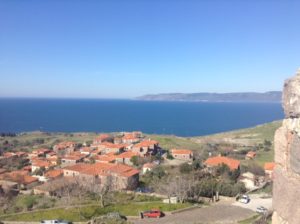

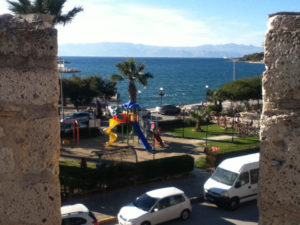
[The next two photos are] shots of the men’s sheds and family dormitories located inside the Moria Relocation Center on the southern part of the island near Mytilene. It’s a jail surrounded by razor wire, but it’s an open jail. Most refugees ended up here. It has a capacity of about 3,000. The European Union (EU) called this operation a “hot spot.” Here refugees can be registered. Once registered, they get a card that allows them to stay in Greece for six months or one month. With this card, they were legal for the moment. They could stay in a hotel or buy a ferry ticket. Who got the six month card changed often, but generally it was for Syrians, Iraqis and Afghans. The point of the card, however, was for them to get on a ferry and get out of Greece. This camp was run by volunteer first responders under the auspices of the UNHCR.
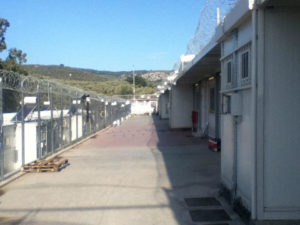
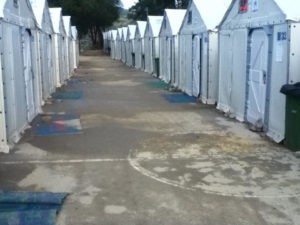
Next door to the Moria Relocation Center was an informal camp site, initially known as “Afghan Hill.” [The next] photo shows the tents that were set up. It was for refugees that did not want to go to Moria or for overflow from Moria. Finally, [not shown is a] shot of refugees exiting a Greek ferry at the Port of Piraeus on the Greek mainland.
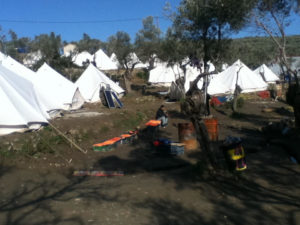
All of this changed on March 20, 2016, the date an agreement between the EU and the Republic of Turkey came into effect. Negotiations on this agreement had been taking place for months prior.
The purpose of the agreement was to stop the flow of refugees to Europe. The borders to Europe like the one in Macedonia would remain closed to refugees. Anyone landing on a Greek island after March 20 would be sent back to Turkey unless they could and did apply for asylum in Greece. For every Syrian returned to Turkey, one Syrian would be sent to an EU country up to a maximum of 72,000. What would happen to all those returned to Turkey, including any Syrians, was unclear.
In exchange for this “service,” the EU would send Turkey six billion euro to help cover costs for keeping Syrian refugees in Turkey, allow Turkish citizens to travel visa free to the EU’s 28 countries and restart the talks regarding Turkey’s membership in the EU.
So, what did this deal mean for Lesvos? It meant the Moria Relocation Center was now a closed prison run by the Greek army. All first responder organizations that had provided food, clothing, medical assistance, etc were excluded. It meant Afghan Hill was closed down. It meant all the first responder organizations were being isolated from the refugees. It meant those refugees returned to Turkey were accompanied by armed guards from Frontex, the EU border police. It also meant the daily average of refugees coming by rubber raft from Turkey declined significantly, from a daily average in March of 851 to a daily average in April to 151 (As of April 13, 2016).
What is my feeling about this? First responders provided basic humanitarian aid in emergency situations to these refugees. They witnessed what was going on and we learned about it from them. The removal of first responders means these “refugees”, just like other refugees such as America’s homeless, the dispossessed from years of neo-liberalism, or those displaced due to the climate crisis are officially “nobodies.” They will be the subjects of stereo-typing and fear mongering. They will be subjected to state violence and criminal gangs. This is a major danger. No good will come of it.
I want to talk a bit about why these refugees are coming to the island of Lesvos.
Near the end of World War I, two people, Mark Sykes representing Britain and Francois Picot representing France were assigned the task of dividing up parts of the collapsed Ottoman Empire which we now know as the “Middle East.” Countries that we know as Iraq, Syria, Lebanon, Iran, Kuwait, Jordan, Palestine were artificial creations that were to be ruled either directly or indirectly by either Britain or France once the war was over. This became known as the Skyes-Picot Agreement.
The countries and boundaries created by this agreement were basically artificial nations ruled by autocratic rulers under the supervision of western imperial powers. When Britain and France withdrew from this area in a military way in the mid-1950s, the US took over as the imperial supervisor. As you can imagine there was a great deal of resentment about this agreement even up to the present time. For example, when ISIS announced the formation of its Islamic State in 2014, it bulldozed the border between Syria and Iraq and announced the end of Sykes-Picot.
Secondly, the US invaded Iraq in 2003 and occupied that country until 2011 when the last US troops were withdrawn. In a few days after taking Baghdad, Paul Bremer, the newly installed administrator of the US occupation, dismissed 65,000 to 70,000 of the elite leadership of the Iraqi Army. He also criminalized the leaders of the Baathist political party that had ruled Iraq for the past three decades. In doing these two things, Bremer dismantled the two key institutions of the secular Iraq nation state.
In its place, the US installed a sectarian government ruled by a religious sect of Islam, the Shi’a, under the premiership of Nuri al-Maliki. While the Shi’a are the largest Islamic sect in Iraq, the Sunni sect has a significant presence in Iraq and world wide makes up by far the largest portion of the Islamic world of 1.3 billion followers.
It was something like if a foreign power came to this country, dismissed every officer of the Army, Navy and Air Force, criminalized every member of the Republican and Democratic parties and set up a Christian government that criminalized or at least discriminated against all the Catholics.
For the next ten years, this sectarian government structure in Iraq led to violent conflict between these two branches of Islam, one of which controlled the government apparatus.
Just after the 2003 US invasion of Iraq, al-Qaeda Central (AQC), still run by bin Laden and Ayman Zawahiri, sent a Jordanian operative known as Zarqawi to Iraq. He set up or al-Qaeda in Iraq, but later changed its name to the Islamic State of Iraq (ISI) Although he was killed by a US airstrike in 2006, he set the tone for what was to take place in Iraq and it was very different than what AQC wanted.
He said the main problem was Shi’a rule, whether in Iraq, Iran or Syria. He believe that the Shi’a were apostates, people who had forsaken their religion and in fact should be killed. He intended to mobilize the Sunni population against this Shi’a rule. Unlike al Qaeda who believed the problem was the “far enemy” like the US, he believed the “near enemy” was the problem, in other words, the Shi’a and the Shi’a rulers.
He also believed in a particular type of jihad. You know, jihad can be as simple as a commitment to being a good Muslim. That is, making your profession of faith, saying your prayers daily, paying you tax to the mosque, fasting during Ramadan and, if you have the funds, traveling to Mecca in Saudi Arabia sometime during your lifetime.
Jihad to Zarqawi, however, was only an offensive war against the Shi’a or anyone else that did not believe in his way of doing things. I read parts of the strategic manual that he followed and is followed by ISIS today. It’s called the Management of Savagery. It’s basically the use of overwhelming violence to assert your dominance and they being prepared to manage the chaos.
When I was reading this, it made me think about the “shock and awe” strategy of Bush, Cheney and Rumsfeld when they invaded Iraq. They believed their use of overwhelming violence would also establish their authority. And, just like ISIS who calls for a war against all, so Bush, Cheney and Rumsfeld said you were either with us or against us as they began their regime of “perpetual war.”
So what seems to be happening in Iraq and Syria today is our system of “perpetual war” meeting the “management of savagery.” You can see the results. Neither side is going to “win” but their strategies will produce a lot of refugees.
There was one final difference with AQC. The ISI leadership believed they could create an Islamic State in present time by taking and holding territory. AQC, or al-Qaeda Central, believe that an Islamic State would only be possible once the imperial powers, like the US, had concluded they should leave the Middle East and the Muslim world alone.
By 2011, the Islamic State of Iraq (ISI) had been rebuilt under the new leadership of al-Baghdadi, and also had more room to maneuver. This happened for two reasons.
First, al-Maliki, the Iraq premier, continued to criminalize the Sunni population even though some of them had helped the US troops defeat AQI in 2006. This gave more credence to the notion that the Sunnis as Sunnis needed to organize and that the US had in fact given Iraq to the Shi’a and to Iran, which has a Shi’a government.
Second, Bashar al-Assad, the ruler of Syria and a member of a Shi’a like sect, had severely repressed the civilian protests in his country, which were a part of the Arab Spring protests of 2011. In the process of repressing these non-violent, civilian protests in the southern city of Daraa, his security forces arrested and tortured some middle school kids who had sprayed painted some anti-regime graffiti. There are a lot of things people will put up with from their governments, but torturing their children is not one.
This action, as well as a host of other grievances, led to the civil war that is still raging. It led to something else. al-Baghdadi, the leader of ISI, sent his agents into Syria to organize Sunni opposition to the al-Assad regime and by June 2014, al-Baghdadi had announced the Islamic State of Iraq and Syria (ISIS).
At this point in time, ISIS has control of the Syrian city of Raqqa and the Iraqi city of Mosul and an area containing around six million people. They control the majority of oil production in Syria and 1/3 of it wheat production. They are estimated to have $2 trillion in assets and an annual revenue of $2.5 billion.
What does all this mean for Syria?
Half of this nation of twenty-two million people is either internally displaced persons (6.5 million) or refugees (4.8 million). It also has at least a quarter million dead and 1.8 million wounded. Its economy is in shambles and it is currently being bombed by a long list of nations: the US, Australia, Bahrain, France, Jordan, the Netherlands, Saudi Arabia, the UAE, Britain, Turkey, Russia and its own regime under Bashar al-Assad. As of February 2016, the US DOD says it has carried out 3,447 air strikes just in Syria alone since August, 2014.
[To the left is] a photo of Aleppo. What’s that man with a kid in each hand walking through this rubble supposed to do? Aleppo was a city of 2.2 million people. I was there in 2010. The eastern part of that city had 1 million people in it, now there are 40,000.
Many of them decided that they must leave Syria. There are 2.7 million in Turkey, 1.2 million in Lebanon. Jordan has about 1 million. Germany took about 500,000 in 2015. Obama said he has a goal of 10,000. Since 2012, the US State Department’s resettlement program has accepted 2,174 Syrian refugees, half of whom are children.
What’s this all mean for us?
Unless we stop this policy of perpetual war there will be a lot more refugees created, either from war, neo-liberal trade agreements, or climate chaos. If first responders are not present to meet their needs, act as a witness, and tell the broader community, we won’t even know they exist. At a minimum, we need to demand a safe and legal access to asylum and resettlement. If we can’t accomplish this, war will be the only condition, the politics of force.
Dan Leahy is a retired Professor of Political Economy and Social Movements from The Evergreen State College and founder and former Executive Director of Washington State’s Labor Education and Research Center.

Be First to Comment